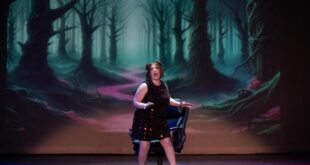Harmony Stempel is an actress of subtlety and precision, exactly the qualities needed for Andrea Kuchlewska’s bracing if goofily named one-woman play Human Fruit Bowl. In one intensive act, Beth, a twenty-something artists’ model (hence the title), takes us on a fascinating, funny, unsparing journey through the psyche of a sharp-minded but aimless young person who by sheer chance has discovered that taking off her clothes and posing motionless for hours in front a class of art students is a decent way of, as she calls it, “making the rent.”
Photo by Andrea KuchlewskaWhat makes the play remarkable is the unusual style of the telling. The script is an artful skein combining narrative and train-of-thought through Beth as she holds poses, frequently nude. It’s persuasive drama precisely because for the most part nothing moves but her mouth and eyes – she’s truly a still life.
With the help of slides, Beth, who unlike her fellow models goes in knowing practically nothing about art, describes some of the famous paintings she comes to learn about and admire, and in the course of her reading finds herself obsessing over the suicide of the artist Pierre Bonnard’s model/mistress. We see a good sampling of Bonnard’s many paintings of his wife in the bathtub (echoing the actual bathtub in which Beth poses) and learn about the legend of his mistress killing herself in a tub – but is that really how it happened? Pursuing the truth of this story is Beth’s entree not only into the world of art, but into deep reflections on what’s true and what’s merely accepted as such by dint of repetition. At the same time it’s our own entree in the world of the artist’s model, a creature whose life story, despite her (or his) timeless importance to the art, is so often lost to history, as Beth adamantly to point out.
Pierre Bonnard, “Crouching Nude in Tub”Meanwhile her nudity has the effect not of causing a spectacle but quite the opposite: It works in tandem with her physical stillness to zero us in on her words and expressions. That’s why the role needs a performer like Stempel, with intense focus and skill and a winning personality. No doubt the actress’s experience as just such a model contributed to the effectiveness of her performance. The play, which has travelled to other cities and countries and appeared in the soloNOVA Arts Festival last year, was Stempel’s idea. I can hardly say enough about how good she is, whether fussing over what pose to choose, reflecting on her unusual circumstances (“It’s totally weird to be naked in the middle of a room”), addressing us directly with her observations about the eye-opening paintings she discovers at the Met (“those paintings blew me away”), giving us both sides of a conversation with an art student who has taken a liking to her, or writing silently in a notebook during breaks between poses. Several times I had to stop myself from shouting out replies to the questions she casually posed to us about our own knowledge of art.
For example, I too have always loved Picasso’s famous portrait of Gertrude Stein. “You look at those, and they’re profound,” Beth cries, “but why? How?” Isn’t that always the question? This little play, written so cleverly and richly, performed with such artful panache, and directed with ease and subtlety by Jessi D. Hill, deserves to be seen by art lovers – and by that I mean lovers of the arts – everywhere. It has two more performances as part of the New York Fringe.
 Blogcritics The critical lens on today's culture & entertainment
Blogcritics The critical lens on today's culture & entertainment



